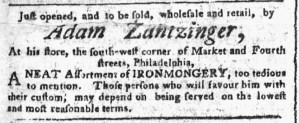What was advertised in a colonial American newspaper 250 years ago today?

“A NEAT Assortment of Ironmongery, too tedious to mention.”
In January 1773, Hugh Roberts and George Roberts continued taking to the pages of the Pennsylvania Chronicle to hawk their wares. They proclaimed that they carried “IRONMONGERY AND BRASS WARES, In their most extensive BRANCHES.” In other words, they stocked some of everything! They also declared that they had a “large Assortment of COPPER WARE, INDIA-METAL WARE, JAPAN’D WARE, and CUTLERY.” The Robertses suggested that the selection would satisfy any of their customers.
They asked readers to take their word for it and, better yet, visit their “WARE-HOUSE” at the corner of Market Street and Grindstone Alley in Philadelphia to see for themselves. They could have published an extensive catalog of their merchandise to demonstrate the range of choices available to consumers. Many merchants and shopkeepers adopted that marketing strategy in the second half of the eighteenth century. Instead, the Robertses inserted a note intended to tantalize prospective customers. “The Ironmongery, Brass and the other Wares, at the said Ware-house,” they asserted, “consist of so great a variety of sizes, patterns and workmanship, that, to particularize the articles in an advertisement, would be too extensive for publication in a news-paper.” In addition to being “too extensive,” such an advertisement may have been more expensive than the Robertses wished to pay.
Adam Zantzinger, who also sold a “NEAT Assortment of IRONMONGERY,” offered a sharper critique of what he considered excessive detail in newspaper advertisements. In his own advertisement, Zantzinger insisted his selection was “too tedious to mention.” Presumably prospective customers would not find browsing his store at the corner of Market and Fourth Streets “too tedious,” especially since they could acquire goods there “on the lowest and most reasonable terms.” In contrast, Jonathan Zane and Sons ran an advertisement that filled an entire column and overflowed into another as they listed hundreds of items from among their “large assortment of IRONMONGERY, CUTLERY, BRASS WARE, SADLERY, DYE STUFFS, PAINTERS COLOURS,” and other items. Perhaps Zantzinger directed his comments at those competitors in addition to making a general statement about advertising practices then in style.
In an era when many merchants and shopkeepers sought to demonstrate the array of choices that they provided for consumers by imbedding lengthy lists of merchandise in their newspaper advertisements, some advertisers rejected such methods in favor of making simple promises that they carried items prospective customers wanted or needed. Their strategy may have been motivated in part by the cost of advertising, but that did not prevent them from making appeals that they believed would resonate with consumers, including highlighting their large selection and low prices.
